
|
Astronomy Picture Of the Day (APOD)
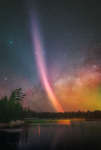 STEVE over Copper Harbor
STEVE over Copper Harbor
5.05.2021
What creates STEVEs? Strong Thermal Emission Velocity Enhancements (STEVEs) have likely been seen since antiquity, but only in the past five years has it been realized that their colors and shapes make them different from auroras. Seen as single bright streaks of pink and purple, the origin of STEVEs remain an active topic of research.
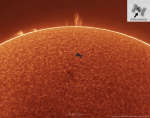 Space Station, Solar Prominences, Sun
Space Station, Solar Prominences, Sun
4.05.2021
That's no sunspot. It's the International Space Station (ISS) caught passing in front of the Sun. Sunspots, individually, have a dark central umbra, a lighter surrounding penumbra, and no Dragon capsules attached.
 Apollo 11: Earth, Moon, Spaceship
Apollo 11: Earth, Moon, Spaceship
3.05.2021
After the most famous voyage of modern times, it was time to go home. After proving that humanity has the ability to go beyond the confines of planet Earth, the first humans to walk...
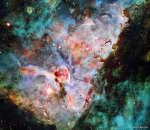 Clouds of the Carina Nebula
Clouds of the Carina Nebula
2.05.2021
What forms lurk in the mists of the Carina Nebula? The dark ominous figures are actually molecular clouds, knots of molecular gas and dust so thick they have become opaque. In comparison, however, these clouds are typically much less dense than Earth's atmosphere.
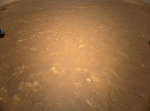 Perseverance from Ingenuity
Perseverance from Ingenuity
1.05.2021
Flying at an altitude of 5 meters (just over 16 feet), on April 25 the Ingenuity helicopter snapped this sharp image. On its second flight above the surface of Mars, its color camera was looking back toward Ingenuity's current base at Wright Brothers Field and Octavia E.
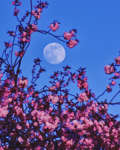 Pink and the Perigee Moon
Pink and the Perigee Moon
30.04.2021
On April 25 a nearly full moon rose just before sunset. Welcomed in a clear blue sky and framed by cherry blossoms, its familiar face was captured in this snapshot from Leith, Edinburgh, Scotland. Known to some as a Pink Moon, April's full lunar phase occurred with the moon near perigee.
 Apollo 17: The Crescent Earth
Apollo 17: The Crescent Earth
29.04.2021
Our fair planet sports a curved, sunlit crescent against the black backdrop of space in this stunning photograph. From the unfamiliar perspective, the Earth is small and, like a telescopic image of a distant planet, the entire horizon is completely within the field of view.
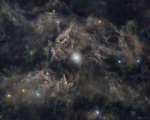 North Star: Polaris and Surrounding Dust
North Star: Polaris and Surrounding Dust
28.04.2021
Why is Polaris called the North Star? First, Polaris is the nearest bright star toward the north spin axis of the Earth. Therefore, as the Earth turns, stars appear to revolve around Polaris, but Polaris itself always stays in the same northerly direction -- making it the North Star.
 Animation: Black Hole Star Shredder
Animation: Black Hole Star Shredder
27.04.2021
What happens if a star gets too close to a black hole? The black hole can rip it apart -- but how? It's not the high gravitational attraction itself that's the problem -- it's the difference in gravitational pull across the star that creates the destruction.
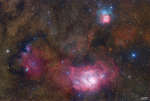 A Sagittarius Triplet
A Sagittarius Triplet
26.04.2021
These three bright nebulae are often featured on telescopic tours of the constellation Sagittarius and the crowded starfields of the central Milky Way. In fact, 18th century cosmic tourist Charles Messier cataloged two of them; M8, the large nebula below and right of center, and colorful M20 near the top of the frame.
|
January February March April May June July August September October November December |
|||||||||||||||||||||||||||||||||||||||||||||||||